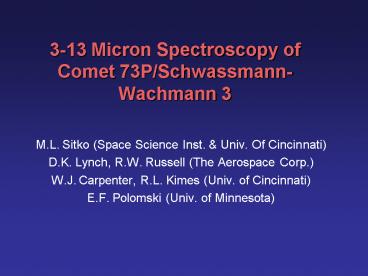313 Micron Spectroscopy of Comet 73PSchwassmannWachmann 3 - PowerPoint PPT Presentation
Title:
313 Micron Spectroscopy of Comet 73PSchwassmannWachmann 3
Description:
3-13 Micron Spectroscopy of Comet 73P/Schwassmann-Wachmann 3. M.L. Sitko (Space Science Inst. ... Observing recently-fragmented comets allows us to observe ... – PowerPoint PPT presentation
Number of Views:72
Avg rating:3.0/5.0
Title: 313 Micron Spectroscopy of Comet 73PSchwassmannWachmann 3
1
3-13 Micron Spectroscopy of Comet
73P/Schwassmann-Wachmann 3
- M.L. Sitko (Space Science Inst. Univ. Of
Cincinnati) - D.K. Lynch, R.W. Russell (The Aerospace Corp.)
- W.J. Carpenter, R.L. Kimes (Univ. of Cincinnati)
- E.F. Polomski (Univ. of Minnesota)
2
Observing recently-fragmented comets allows us to
observe material once hidden beneath their
surfaces
The two brightest components of the fragmenting
Comet Schwassmann-Wachmann 3 were observed using
the IRTF with The Aerospace Corporations
Broad-band Array Spectrograph System (BASS) on
May 18 19, 2006 (UT)
3
The 2 brightest components, B C, exhibited
significant variability over time scales of hours
Component C underwent an 80 increase in 2 hours
on May 19, presumably due to either more fresh
surface being exposed to the Sun by rotation of
the nucleus, or the occurrence of a fragmentation
event
4
Both components exhibited a strong 10 micron
silicate band of nearly identical structure.
In Oort cloud comets, this band can be very
strong (twice the flux level of the continuum) or
nearly absent. In Jupiter family comets, it is
almost always weak.
The strength of the band in SW3 indicates (as did
the Deep Impact of Tempel 1) that Jupiter family
comets are formed with small grains throughout
their interiors, but that long-term loss of these
grains occurs from their surfaces.
5
The large wavelength coverage of BASS, and its
ability to obtain precise photometric imaging at
visible wavelengths, allows greater constraints
to be placed on models than is possible with the
8-13 micron coverage of most mid-IR spectrographs.
Above unfiltered (false color) image of SW3-C
obtained with the BASS guide camera. Right BASS
spectra and photometry obtained with the guide
camera using narrow-
band filters (blue points), allow the spectral
energy distribution to be determined from 0.44 -
13 microns. The grain components include
amorphous carbon, amorphous olivine, amorphous
pyroxene, and crystalline olivine. The sum of
these is the upper black curve. To this is added
the scattered solar spectrum, normalized to the
narrow-band photometry. The extension into the
visible indicates a mean reflectivity of 13, and
decreasing toward shorter wavelengths.































